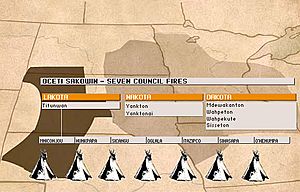Great Sioux Nation facts for kids

The Sioux people were united in a confederacy of seven members, called the Seven Fires Council
(the map still misnames the Yankton-Yanktonai grouping as Nakota) |
|
| Legislature | Council |
|---|---|
| Main body | Subdivisions of dedicated tribes |
The Great Sioux Nation is the traditional way the Sioux people of North America organized themselves. The people who speak the Sioux language are known as the Oceti Sakowin (pronounced O-CHAY-tee Sha-KO-ween). This name means the Seven Council Fires.
These seven communities sometimes group themselves into three main language groups: Lakota, Western Dakota, and Eastern Dakota. However, each of the seven communities is an important part of the historic confederacy. Today, this name mostly describes a group of people who share a language, culture, and sometimes political goals.
Since 2019, the Sioux language has been an official language in South Dakota.
Who Are the Sioux People?
The Great Sioux Nation is made up of different groups. These groups are organized by their language and where they live. All three main language groups are part of the larger Sioux language family.
Here are the main groups and their smaller parts:
- Lakota (also called Lakȟóta, Thítȟuŋwaŋ, or Teton Sioux)
- Northern Lakota (Húŋkpapȟa, Sihásapa)
- Central Lakota (Mnikȟówožu, Itázipčho, Oóhenuŋpa)
- Southern Lakota (Oglála, Sičháŋǧu)
- Western Dakota
- Yankton (Iháŋktȟuŋwaŋ)
- Yanktonai (Iháŋktȟuŋwaŋna)
- Eastern Dakota (also called Santee-Sisseton or Dakhóta)
- Santee (Isáŋyáthi: Bdewákhathuŋwaŋ, Waȟpékhute)
- Sisseton (Sisíthuŋwaŋ, Waȟpéthuŋwaŋ)
Where the Sioux Live
The term "Great Sioux Nation" can also refer to a large area in the western and midwestern United States. While it's not a legal state, this area includes many recognized Indian reservations where Sioux tribes live today.
Some of these reservations include:
- Pine Ridge Indian Reservation (for the Oglala people)
- Rosebud Indian Reservation (for the Sićangu or Brulé people)
- Standing Rock Indian Reservation and Cheyenne River Indian Reservation (for the Hunkpapa people)
- Cheyenne River Indian Reservation (also for the Minniconjou, Sans Arc, and Two Kettles people)
- Crow Creek Indian Reservation
- Lower Brule Indian Reservation
- Santee Indian Reservation
- Yankton Sioux Indian Reservation (for the Yanktonai people)
- Flandreau Indian Reservation
- Lake Traverse Indian Reservation (for the Sisseton-Wahpehton people)
- Lower Sioux Indian Reservation
- Upper Sioux Indian Reservation
- Shakopee Mdewakanton Sioux Community
- Prairie Island Indian Community
- Spirit Lake Tribe (formerly Devil's Lake Reservation)
This region also includes land that was once part of the Great Sioux Reservation. This larger reservation was later divided into smaller parts in the 1800s. It also includes other lands that were not given up by treaties in four states, plus parts of these states:
The Great Sioux Nation's lands are mainly in areas where Sioux tribes have legal claims based on treaties with the United States government. An important example is the Treaty of Fort Laramie.
Historically, the Great Sioux Nation and the United States government have had challenging times. Some of the last major conflicts between Native American peoples and the U.S. Army, like the Battle of the Little Bighorn and the Wounded Knee Massacre, involved the Sioux people.
Sioux in Canada
The Assiniboine people, also known as Nakota, live north of most Sioux groups. They speak a Siouan language that is closely related to the Sioux language. However, they are not considered part of the modern Oceti Sakowin.
The Assiniboine were among the first Siouan-speaking peoples to leave the Eastern Woodlands and move to the Great Plains. They became a separate group before 1640, when French missionaries first wrote about them. Because of this, other Sioux speakers called them Hohe, meaning "rebels."
Later, the Canadian Nakoda (Stoney) people may have started as the westernmost group of the Assiniboine. They were seen as a separate people after about 1744. In the 1800s, more groups from the Dakota people and some from the Lakota people also moved to Canada. Their descendants still live in several First Nations communities there today.

